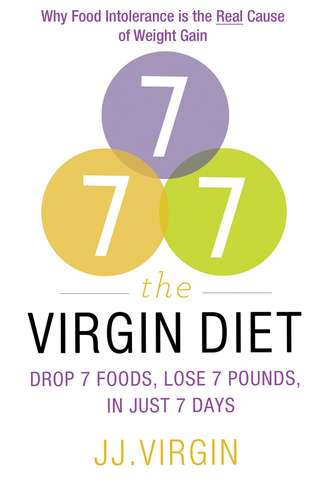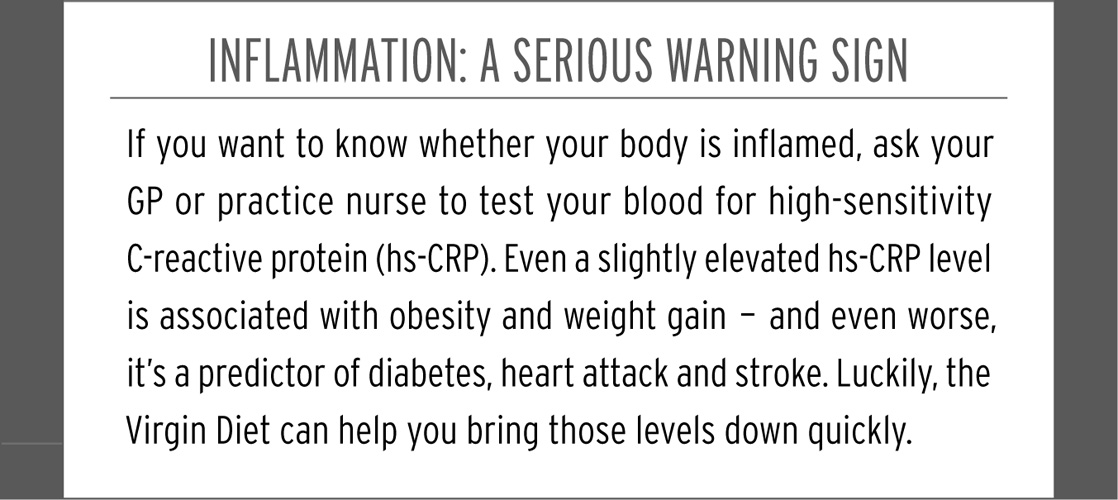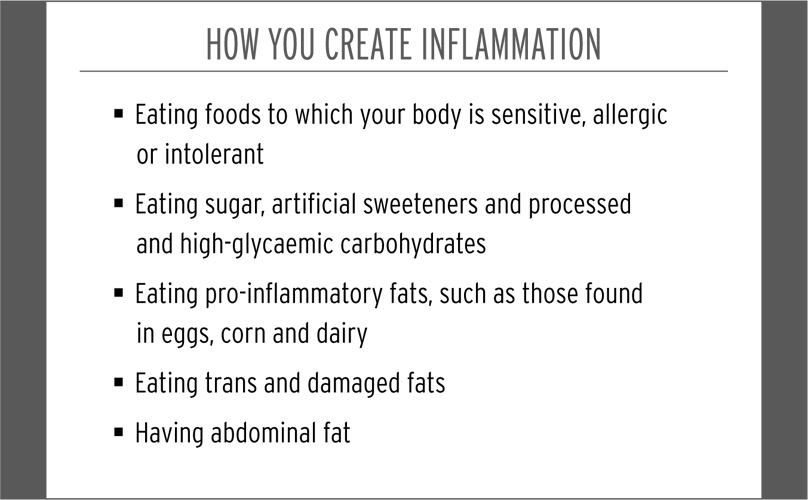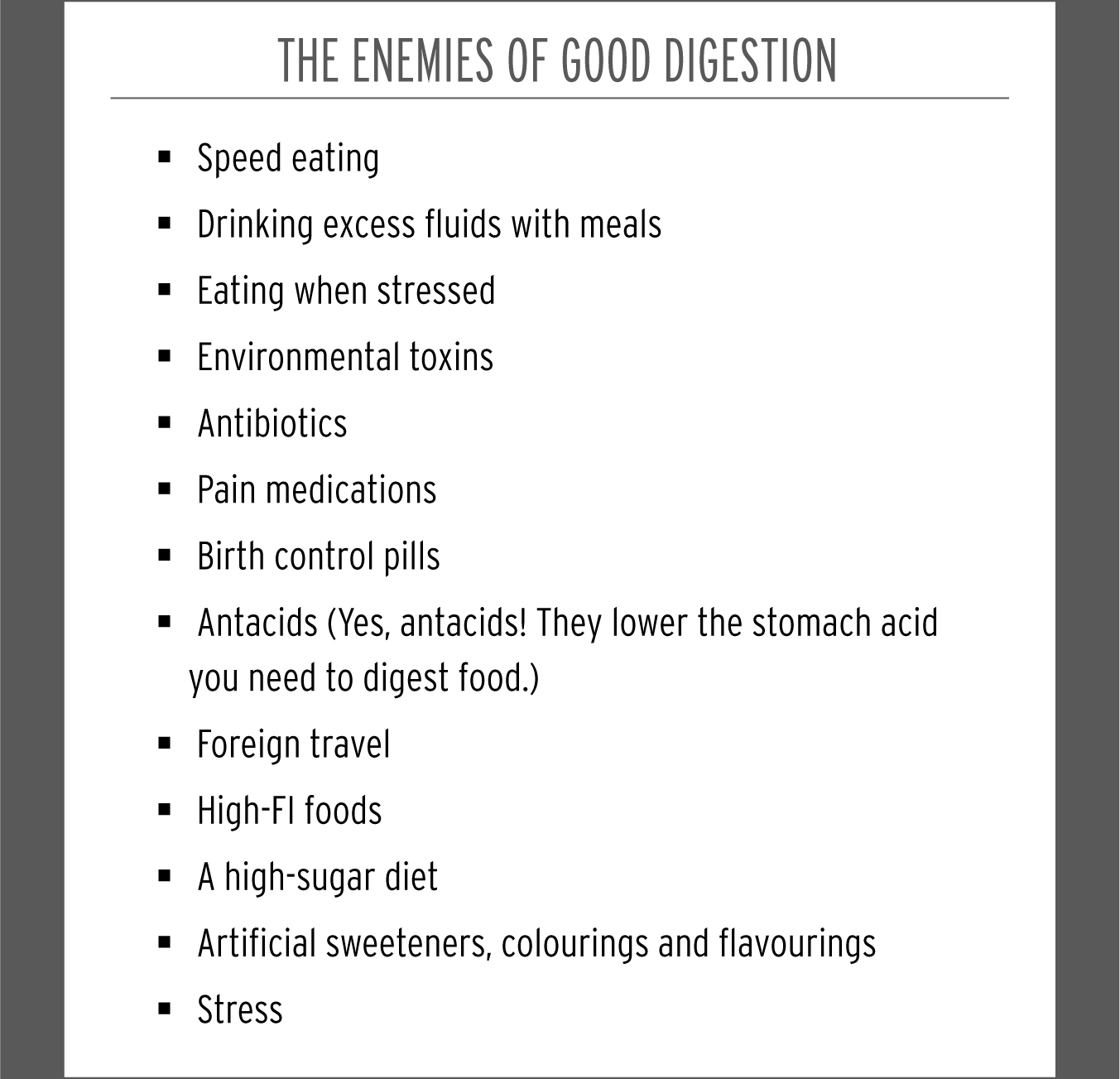
Полная версия
The Virgin Diet: The US Bestseller

Food intolerance is an umbrella term that covers three ways other than food allergies that things can go wrong: true intolerance, food sensitivities and food reactions.

Some people’s bodies simply have trouble tolerating certain foods, such as gluten (found in many grains, pastas, baked goods and processed and prepared foods), lactose (found in dairy products) or MSG (monosodium glutamate, a form of salt used as a flavour enhancer in many processed and prepared foods). Usually, this is because the intolerant people are lacking a specific chemical or enzyme that they need to digest the food. This is simply a genetic problem, and there isn’t much you can do about it except to avoid the foods. The good news is that on the Virgin Diet, you will avoid these difficult foods, which will make it easier for you to lose weight, look younger and feel healthier.

Like allergies, food sensitivities are a type of immune reaction, but they mobilize a different type of antibody than food allergies do – not IgE, but its cousin, immunoglobulin G, or IgG. These IgG antibodies produce symptoms, too, but they act more slowly than IgE antibodies. Whereas allergic reactions are swift, food sensitivity symptoms don’t appear until several hours or even a few days after you’ve eaten, making it very difficult to link them to the problem food.

Food sensitivities keep your immune system fired up on a chronic basis.

Here’s another way in which allergic responses differ from sensitive ones: allergic responses are acute, whereas sensitivity responses are chronic. In other words, an allergy is a specific response: your immune system is activated, it flares up, it sends out its aggressive battery of IgE antibodies and, hopefully, it calms down. Food sensitivities, by contrast, can keep your immune system fired up on a chronic basis because you keep consuming the foods that set them off. If yoghurt, eggs, soy milk and whole-wheat bread are a frequent part of your diet – and especially if you’re eating them every day – your system is overwhelmed with problem foods, and your immune system never really calms down. This creates a number of problems, particularly inflammation, as I’ll explain a bit later. But first, let’s play food detective. Here are the typical symptoms of food sensitivity. Do any of them sound familiar to you?
Digestive trouble, such as bloating, wind, constipation or diarrhoea
Sleep issues, such as fatigue, insomnia or waking in the middle of the night
Congestion, sneezing and coughing
Muscle aches and joint pain
Dark circles under your eyes
Dull, lifeless hair
Skin problems, including acne and rosacea
Mood problems, such as lack of focus, brain fog, depression, anxiety or irritability
Poor or unsteady energy
Weight gain
Premature ageing
If you’re struggling with any of these symptoms, you are almost certainly struggling with food sensitivities and perhaps with other types of food intolerance as well.
Food sensitivity is incredibly common. It affects at least 75 per cent of us and is a major factor in weight gain and weight retention. Again, the good news is that the Virgin Diet will help you cope with your food sensitivities, first by pulling problem foods from your diet and then by healing your system so you might eventually be able to tolerate some of those foods.

When you load your body up with too many carbs or too much sugar, you’re setting yourself up for blood sugar spikes and crashes. This in turn messes with your insulin response – your body’s attempt to move sugar out of your blood and into your cells. Your insulin response works best when your blood sugar levels are nice and steady and in the ideal range. The Virgin Diet supports this process and helps you avoid food reactions by having you eat ideal amounts of clean, lean protein; healthy fats; non-starchy veggies; and high-fibre, low-glycaemic carbs every 4 to 6 hours. Yes, pulling the top 7 high-FI foods is important, but so is the timing of your meals and the combinations of foods you eat. Consuming something sweet or high-carb – a piece of cake, a handful of dried fruit or even a glass of orange juice – causes your blood sugar to spike and messes with your insulin response. As you’ll see in Chapter 7, artificial sweeteners can also create adverse reactions. Anything that interferes with blood sugar and insulin response disrupts your stress hormones – all of which makes you more likely to gain and retain weight.

Food intolerance produces a host of symptoms, which is bad enough. But it also causes a number of interrelated problems, each of which makes all the others worse. One of those problems is inflammation, a major cause of weight gain and weight-loss resistance.
Ironically, inflammation is a necessary by-product of any intense immune response – that is, it’s supposed to help your system heal. When your body is invaded by a toxin, bacteria or a virus or traumatized by a wound, your immune system swiftly triggers a cascade of healing and protective chemicals that rush to the site. You can think of your immune system as an ambulance that comes roaring to the rescue after an accident.
But suppose the ambulance driver is so anxious to reach you that he crashes right through the side of your house? That’s inflammation – the negative side effects of the healing process.

Inflammation puts on the pounds in a number of different ways.

The four classic inflammatory responses are redness, heat, pain and swelling, symptoms that are easily visible when the injury can be seen. Think of how a cut on your finger turns red and how warm and tender the skin becomes, or imagine how an insect bite on your ankle might swell. Those reactions occur inside your body, too, when a high-FI food triggers an immune reaction. Your digestive tract becomes inflamed. If you frequently eat foods that inflame your system – either foods to which you’re sensitive or foods that contain inflammatory fats (e.g., dairy, eggs and corn) – then you’re likely to suffer from chronic low-grade inflammation. And you’re running the risk of weight-loss resistance and obesity.
Inflammation puts on the pounds in a number of different ways:
Chemical changes. Inflammation makes your body resistant to key chemical messengers that help you burn fat, tolerate stress and normalize your appetite and cravings. For example, inflammation keeps your body from ‘hearing’ cortisol, the key stress hormone. As a result, your cortisol levels rise, stressing you out, storing fat around your waist and causing you to crave carbs. Cortisol also lowers your serotonin, the feel-good brain chemical that helps you feel calm and optimistic and sleep well. Eventually, your body gets tired of producing all that excess cortisol, and your levels drop, causing you to feel sluggish, unmotivated and fatigued.
Inflammation also creates resistance to leptin, the hormone that regulates feelings of hunger and fullness. Leptin resistance means that leptin can’t get into your cells. This makes you hungrier, so you eat more, well past the point where your brain would normally be signalling ‘enough’.
Finally, inflammation keeps your body from responding properly to adiponectin, which helps regulate blood sugar and body fat. Add up all these responses, and you get weight gain.
Insulin resistance. Insulin is a hormone that moves sugar out of your bloodstream and into your cells. When I say, ‘sugar’, I don’t just mean the sweet white stuff that sits on the table. I mean the starches found in grains, the fructose and glucose found in fruits and vegetables and the lactose found in milk. These sugars enter your blood, where they are meant to provide energy for your body and brain, as long as insulin helps move them into your cells.
But when you are consuming too much sugar (in the form of sweets, starches or dairy products) or when your system is inflamed, your body secretes too much insulin and keeps the insulin in your bloodstream longer than it’s supposed to. After a while, your cells can’t ‘hear’ all that excess insulin. Your insulin receptors stop responding to the insulin, and your blood sugar remains high. You may eventually have trouble manufacturing enough insulin, putting you at risk of developing diabetes. Meanwhile, you can’t use that extra blood sugar for energy, and it ends up getting stored as fat.
In addition, all that excess insulin in your blood tells your body you have enough sugar around for fuel, so it doesn’t need to burn stored fat. Insulin resistance basically slams the doors to your fat cells shut. Insulin resistance also makes it nearly impossible to lose weight. And inflammation virtually guarantees that you will suffer from insulin resistance.

Insulin resistance slams the doors to your fat cells shut.

Fluid retention. Inflammation doesn’t just help you hold onto your body fat, it also causes you to retain fluids so you feel bloated and heavy.
Digestive problems. When inflammation rages through your intestines, your digestive system can’t operate efficiently. If you have an imbalance of gut bacteria, with more bad bacteria than good, you will actually extract more calories from the food you eat and store them as fat. If your gut wall is damaged and leaky, you will struggle to be able to absorb your nutrients. The result is that even though you are eating, you still feel hungry and unsatisfied because your body can’t get what it needs from your food.
Loss of energy. Inflammation causes you to feel sluggish and fatigued. If your body is inflamed, you are not going to feel like moving much, so you become even more sedentary. The less active you are, the more resistant to insulin you become – and the vicious cycle continues.
I hope you’re beginning to see why I told Leslie to pull out of her diet any high-FI foods that might be causing an inflammatory response. The fastest way to gain weight that you can’t lose is to allow your body to become inflamed. And the fastest way to drop those extra pounds is to remove the sources of inflammation and let your body heal. That’s what the Virgin Diet is all about.


As we just saw, inflammation causes you to gain and retain weight in several different ways – and those extra fat cells don’t just sit there, either. They release more inflammatory chemicals, creating the mother of all vicious cycles. Inflammation can lead to obesity. And fat – especially belly fat – releases inflammatory chemicals called cytokines, which are messengers that your body uses to start the inflammatory process. So your fat cells are producing more inflammatory messengers, and all that inflammation is making you gain more weight, and then your fat is basically making you more fat! How unfair is that?

Fat releases inflammatory chemicals called cytokines.

So all that extra fat you might be carrying around is not benign, like a backpack. It’s more like carrying a bomb in your backpack. It’s why I want you to lose fat quickly and lower inflammation quickly by pulling the 7 high-FI foods from your diet.
Following the Virgin Diet will also help you overcome insulin resistance. As part of the programme, you’ll eat every 4 to 6 hours and stick to moderate portion sizes of clean, lean protein; healthy fats; high-fibre, low-glycaemic carbs; and non-starchy vegetables. (I go into more detail about the programme in Chapter 8.) This is the fastest way I know to get your blood sugar levels balanced and your insulin working efficiently once more.


Inflammation doesn’t only create insulin resistance. It also creates leptin resistance, which makes it even harder for you to lose weight.
Leptin is a hormone that responds to how much you’ve eaten and signals the brain that you’ve had enough (satiety is the technical term). Leptin also helps burn fat by cueing your metabolism to run faster when you have extra fat to burn and slowing down your metabolism when your body needs to hold onto fat. You can see how our ancestors might have needed this hormone to help adjust their metabolisms depending on whether food was plentiful or scarce.
When leptin is working well, you eat until you don’t need any more food and then you stop. When your system is leptin-resistant, you have a lot of leptin circulating in your blood, but your brain can’t ‘hear’ it. You end up with too much leptin in your blood and not enough in your brain. That’s the situation for the vast majority of overweight people. As a result, they experience increased hunger, food cravings and weight gain. Even though they’re overweight, their bodies believe they’re hungry and go into a state of fat storage.
If you want to lose that extra weight, you have to heal the leptin resistance. Healing inflammation will go a long way towards getting your leptin working properly again. And pulling the high-FI foods is key.

If you want to lose that extra weight, you have to heal the leptin resistance.

Meanwhile, if you keep eating high-FI foods, you continue to feed the problem. You might think you are making healthy choices with your nonfat yoghurt, omega-3–rich eggs and low-fat soy milk, but every bite of high-FI food is potentially triggering an immune response that could flood your body with inflammatory chemicals and start the whole cycle over again. So basically, any time you eat a problem food, you’re setting yourself up for weight gain.

Any time you eat a problem food, you’re setting yourself up for weight gain.

All of the top 7 high-FI foods are potential sources of inflammation, which is why it’s so important to pull them from your diet. Once you do so, your inflammation will disappear, your symptoms will disappear – and those extra pounds will disappear, too.

There is another factor that might be making you fat and old before your time: poor digestion. When digestion works well, it is a beautiful thing, but when it’s out of whack, it can be a huge contributor to weight gain.
Bacteria, also known as flora or gut flora, is crucial to good digestion. Believe it or not, we have more than 500 species of different bacteria in our gastrointestinal tract. In fact, we have more bacteria than we have cells. Most of that bacteria is good for us; it helps break down food, absorb nutrients and keep our immune systems primed. Some of that bacteria is bad – the kind that attacks our cells or produces toxins.
The key thing with gut bacteria is making sure that we have the ideal amount of good bacteria that we need. So, focus on promoting the good bacteria that will help support your gut immune system and keep the bad bacteria at bay.
How do you do that? First, protect your good bacteria. You might want to take probiotics, which are supplements that support bacterial growth. If you take antibiotics, which kill a lot of good bacteria while they’re gunning for the bad, upgrade probiotics from ‘good idea’ to ‘absolutely essential’. You always want to follow any antibiotic treatment with a round of probiotics.

You can further support your good bacteria with prebiotics, which is soluble fibre that feeds your gut flora (for example, garlic, onions, asparagus and dandelion greens), and with fermented foods, such as pickled ginger, kimchee and sauerkraut. We also need good gut bacteria to make vitamin K, which is important for immune function.


There is yet another piece to the inflammation–immune system puzzle: eating high-FI foods can contribute to a condition known as leaky gut syndrome.
Leaky gut is pretty much what it sounds like. The cells of your intestinal lining (your gut) are supposed to be pressed up tightly against one another, creating tight junctions. These junctions keep partially digested food securely inside your intestines, where it belongs.
Sometimes, though, your intestinal lining is compromised, allowing particles of partly digested food to leak out into your bloodstream. Other problematic stuff can get out, too, including microbes, waste and toxins.
When these substances enter your bloodstream, your body treats them as foreign invaders and responds accordingly. Your immune system releases a cascade of inflammatory chemicals designed to neutralize the threat, which can also wreak havoc on your intestinal lining. As a result, you have a much harder time absorbing nutrients, which might even cause you to eat more – and gain weight.
Eventually, the poorly digested food combines with IgG antibodies to form large bodies known as immune complexes. These circulate through the bloodstream until they are deposited in various tissues, where they create localized inflammation. That’s how you end up with the symptoms we’ve talked about – the rashes, joint pain, headache, fatigue and skin eruptions.
All of these symptoms together can make you feel as though your whole body is breaking down. You might be tempted to think that this is what happens naturally as you age. It isn’t. It’s what happens when you suffer from leaky gut. If you’ve been eating the wrong foods for years, you’ll probably develop more symptoms over time, as the problem worsens and symptoms build up.
Ironically, your body starts to crave the very foods that are making you sick. That’s because if you keep eating high-FI foods, your body keeps making antibodies to protect you from them. If you try to cut out a particular high-FI food, you have all these antibodies roaming around in search of it, ready to zap it with their special protective chemicals. These would-be protectors actually cause you to crave the food they’re longing to zap, setting you up for a vicious cycle of inflammation and weight gain.
Food intolerance can create leaky gut, but other factors can, too:
Chronic inflammation
Lactose intolerance
Gluten as it triggers the release of the protein zonulin, which loosens the tight junctions in the gut
A low-fibre, high-sugar diet, which lowers your levels of stomach acid and contributes to leaky gut
Poorly digested food, which may be caused by speed eating or stress eating
A compromised immune system or an autoimmune condition, such as asthma, allergies or rheumatoid arthritis
Overuse of non-steroidal anti-inflammatory drugs (NSAIDS), such as aspirin and ibuprofen
Infections, including viral, bacterial, yeast and parasitic
Antibiotics
Accutane (a form of vitamin A used to treat acne)
Acid blockers
Excessive alcohol consumption
Cytotoxic drugs and radiation
Exposure to heavy metals
Exposure to moulds
Exposure to toxins
If you suffer from irritable bowel syndrome or irritable bowel disorder, you almost certainly have leaky gut as well.
The major cause of leaky gut, however – and the one that’s been most challenging for me personally – is stress because it causes your gut to become more permeable. So if you’ve been going through an especially tough time or if your life is chronically stressful, those extra pounds (and unpleasant symptoms) might well be caused by both leaky gut and inflammation.
Leaky gut isn’t just caused by food intolerance, it also causes food intolerance. As undigested food leaks through those open spaces in your gut, it makes its way into your bloodstream, and your immune system goes wild. Eventually, even foods that you were not previously sensitive to can become problem foods for you. So, we’re looking at a vicious cycle in which leaky gut, inflammation and food intolerance all reinforce one another.
Here’s the good news: if you remove the offending foods, your symptoms usually vanish, and the excess weight starts to come off. Once you heal your leaky gut, you might even become able to tolerate foods to which you are now sensitive. And the really good news is that you can heal leaky gut and perhaps also overcome at least some of your food intolerance through the Virgin Diet. When you drop the top 7 high-FI foods and load up on healing foods, you give your body a fresh, healing start. Meanwhile, you’ll drop up to 7 pounds in 7 days and look years younger. It’s a win-win.



